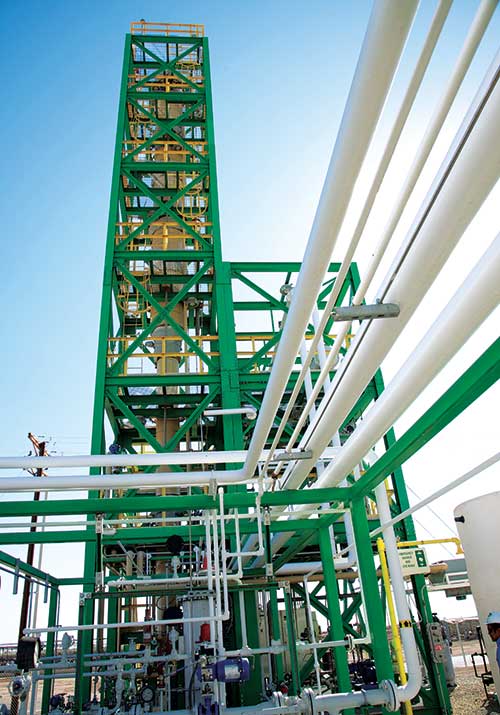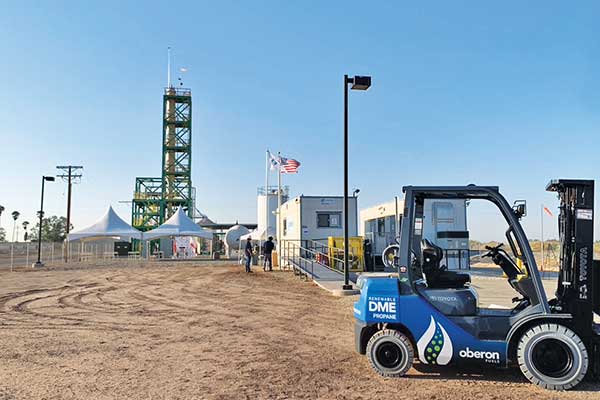Propane industry offers renewable LPG amid climate concerns

Blending dimethyl ether (DME) with conventional propane can produce a renewable LPG product. Photo courtesy of Oberon Fuels
As the world closes the books on 2020, a changing climate is at the top of many minds.
The goal to lower carbon emissions is widely discussed, with many scientists saying the world must act now to prevent both short- and long-term consequences to the earth and the way people live their lives.
In fact, two-thirds of the world’s economy is headed toward carbon neutrality, according to Eric Johnson, managing director of Atlantic Consulting, who spoke during the World LPG Association’s 2020 e-LPG Week.
The propane industry can play a key role in offering an affordable solution. First, traditional propane is a clean-burning fuel, so its users are emitting fewer carbon molecules than gasoline or diesel users.
Furthermore, the propane industry and its partners are working to develop and distribute renewable propane, or bioLPG, and it is already available for end users today. Renewable propane is identical to traditional propane in its chemical makeup and can be used in place of traditional propane without any changes to the necessary engines, tanks or equipment. In addition to being a drop-in fuel, renewable propane has a lower carbon intensity than electricity.
Renewable propane production processes
There are several pathways to producing renewable propane.
For example, bioLPG can be achieved by blending conventional LPG with other renewable fuels. A recent development in the industry is the blending of dimethyl ether (DME) and propane. DME is a clean-burning and renewable fuel made from any methane source, and handles similarly to propane.
Traditional propane has a carbon intensity of about 80, according to the California Air Resources Board, while gasoline ranks at 95 and diesel at 96. DME has a carbon intensity of -278 when derived from dairy biogas. When that DME is blended with traditional propane at a 20:80 ratio to create bioLPG, its carbon intensity drops to just 11.
Renewable propane can be used in the same applications as traditional propane. DME producer Oberon Fuels partnered with SHV Energy and Suburban Propane in 2020 to produce and distribute the propane-and-DME blend.
The company is focusing on marketing the fuel for the transportation market initially, but renewable propane can be used for heating and cooking, as well.
“It’s a really exciting time for renewable fuels because you have traditional refinery infrastructure that’s now being leveraged to make [renewable fuels],” says Rebecca Boudreaux, president and CEO of Oberon Fuels.
Renewable propane can be produced as a byproduct of renewable jet fuel or renewable diesel, both of which convert waste greases, plant and vegetable oils, and animal fat into fuel.
“Many refineries are beginning to contemplate conversion to biodiesel production, which will naturally produce renewable propane as a byproduct,” says Michael Stivala, president and CEO of Suburban Propane. “This is an evolving source of renewable propane supply, but it will take some advocacy and education on the part of the propane industry.”
Where renewable propane stands today

Oberon Fuels has partnered with propane industry companies to produce and distribute DME. Photo courtesy of Oberon Fuels
Renewable propane is available today, and many experts predict worldwide propane demand can be met with renewable propane by 2040, according to the Propane Education & Research Council.
There are also several retailers that offer renewable propane as an option for customers, including Suburban Propane, Blue Star Gas and Kamps Propane.
While renewable propane can be utilized in any application that uses traditional propane, the transportation sector is a prime early target.
For example, California’s Elk Grove Unified School District adopted renewable propane-powered buses in December 2019. Gary Dodson, manager of fleet maintenance for the school district, says renewable propane has proven itself to be beneficial for the fleet.
“Gasoline, diesel, renewable diesel, propane, renewable propane, ethanol, electric, hybrids, CNG – we’ve tried just about everything to improve our [carbon] footprint,” Dodson says during a Western Propane Gas Association (WPGA) webinar.
Dodson says that renewable propane allows the buses to travel farther distances when compared to electric buses, and less routine maintenance is needed with the buses now than when they were powered by other fuels.
In addition, Josh Simpson, vice president of marketing at Kamps Propane, urges retailers looking to offer renewable propane to take the first steps now.
“Eventually, this will be a part of what I imagine will occur in every marketplace,” Simpson says in a WPGA webinar. “For the companies that take this moment, allocate resources and prepare to execute when their time comes, if you start planning now so you’re ready then, the future of your business is kind of unlimited.”
Simpson also encourages companies to educate themselves on renewable propane and its benefits so they are prepared if customers inquire about the fuel.
“We need to embrace what this represents for the future of our industry, and designate a person or people within our companies to become an expert on renewable propane,” he adds.
The industry’s role in promoting progress
In order to position propane as a key part in the future to reduce emissions, the industry must communicate to and educate those in government and decision-making positions about the benefits of the fuel.
“We need to do a much better job staying in front of legislators and regulators, making sure we’re pounding the message on what impact we’ve had already,” Stivala says. “We have to demonstrate not only that we’re willing to talk about it, but we’re willing to innovate and invest in new technologies of the future.
“We should be able to acknowledge that reducing global greenhouse gas emissions is critical to the health and safety of our global society, but I think we can achieve the goals of reducing the global carbon footprint by embracing new technologies while sticking to who we are as a global LPG industry,” Stivala explains. “We need to demonstrate a willingness to innovate before government authorities and regulators force misguided policies that are singularly focused on the electrification of everything without regard for infrastructure and practical applications.”
















